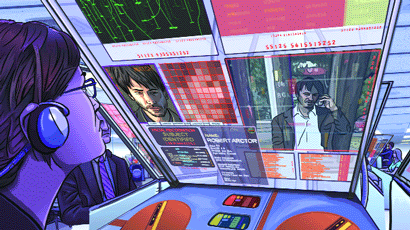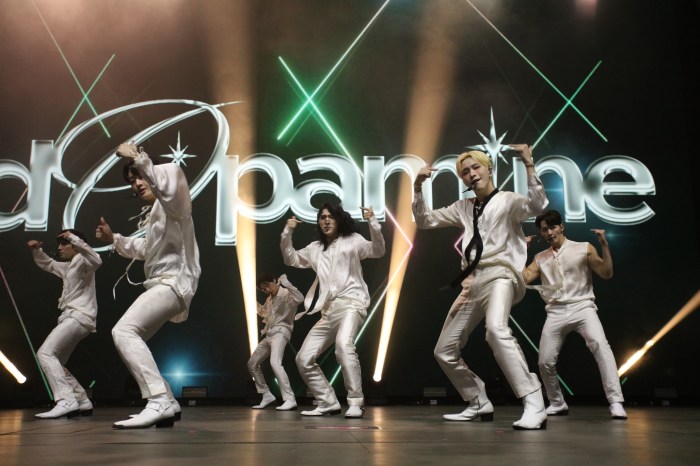Linklater’s animated dystopian fable
Arrayed in junkie chic and heaped with expectations, Richard Linklater’s animated treatment of Philip K. Dick’s 1977 novel “A Scanner Darkly” plays like a heartbreak tango scored to the strains of a post-democratic American twilight.
Culled from the late author’s own tour through the ’60s drug demimonde, “A Scanner Darkly” envisions an America “seven years from now,” when a de facto police state has merged with shadowy mega-corporations to infiltrate every recess of citizens’ lives. Individual rights have long since been abolished, and liberties are consigned to vice. Mass acquiescence to martial law is lubricated by rampant addiction to the insidious Substance D (for “Death”), a psychotropic that induces paranoid stupor, unquenchable dependency, and with prolonged use, engulfing psychosis.
“A Scanner Darkly” stands with “Time Out of Joint,” “The Man in the High Castle,” “Dr. Bloodmoney,” and several other works at the core of Dick’s legacy, and was vouchsafed to Linklater at discount by the author’s estate after earlier abortive attempts to bring it to the screen. Dick’s family was reportedly swayed by Linklater’s pledge to honor the author’s memento mori—on the novel’s final page is a dedication to fifteen loved ones claimed by drug abuse, including the mother of one of his daughters, reproduced at the film’s end.
The visual allure of “A Scanner Darkly” is enhanced by greater depth of field and other recent refinements to animator Bob Sabiston’s trademark “interpolated rotoscopy” software, employed less satisfyingly in Linklater’s “Waking Life” (2001). A 15-month animation process, tracing over preassembled live-action footage with molten chromatic planes, yielded not only canny effects that would have been exorbitant in the Industrial Light & Magic paradigm, but moreover expresses Dick’s thematically vital disjuncture between malleable perception and the fugitive real.
As the film’s main title appears over an extreme close-up of monstrous aphids whirling down a filthy shower drain—as the D junkie Freck (Rory Cochrane) scrubs a hallucinated infestation sprouting from his hair—it’s obvious we’re treading closer to the lysergic netherworld of William S. Burroughs than to the brushed-steel patinas and techie fetishism of “Minority Report” or “Total Recall,” among other Dick adaptations.
Emblematically the setting is Anaheim, home of Tomorrowland. In a conference room at the local Brown Bear Lodge we meet Bob Arctor (Keanu Reeves), an undercover narcotics agent for the Orange County Sheriff, addressing an assembly on the war against “drug terrorists” while clad in a government-issued “scramble suit.” Dick’s major fantastic invention here, the scramble suit is best described by him:
[The] design consisted of a multifaceted quartz lens hooked to a miniaturized computer whose memory banks held up to a million and a half physiognomic fraction-representations of various people … projected outward onto a superthin shroud-like membrane large enough to fit around an average human.
The wearer appears to the civilian eye as an indistinct blur of composite features, an externalization of Dick’s signature obsession with the instability of identity. But immediately, trouble’s afoot. Arctor is too fried on D himself to get through his oration, and despite commands piped into the headset he truncates the lecture. Soon we realize this is hardly the beginning of his collapse; we’ve merely entered mid-plummet.
Arctor’s principal assignment is Donna Hawthorne (Winona Ryder), a second-rung dealer whom the cops hope will lead to her suppliers. To secure Donna’s confidence he’s bought progressively larger quantities of D from her, which he ingests liberally in the line of duty, and kindled a romance, if that’s the word for their sporadic intimacy. Fronting as a fulltime junkie, Arctor’s home is also his workplace, a blighted ranch at the end of a cul-de-sac, moated by weeds. Arctor shares the dump with two hangers-on, the gregarious ditz Luckman (Woody Harrelson), and verbose, wily Barris (Robert Downey, Jr.), who becomes Arctor’s nemesis.
The actors exult in Linklater’s handling and emit a contagious unity of purpose. Reeves is every inch the marquee idol beneath the scuzz, rocking his shoulders and gyrating his waist unmistakably even while obscured by the scramble suit. Ryder is loose and focused inside Donna’s tense persona, plumbing her noirish deceptions. And Cochrane scores with a botched overdose—sold psychedelics instead of the desired lethal barbiturates, the hapless Freck embarks on a marathon trip in which an eye-studded anthropoid materializes with a parchment scroll, declaring, “Your sins will be read to you ceaselessly, in shifts, throughout eternity.”
Downey comes close to most valuable player. Catalyzing the ensemble with surefire comic instinct, he’s indelible yet lacks the requisite touch of menace. Whereas the novel’s Barris is plainly sinister, it’s harder for us, curled up in Downey’s pocket, to accept that he’d sit ghoulishly by while Luckman asphyxiates on a TV dinner, waiting until he’s passed out to dial 911, or sabotage Arctor’s brakes, resulting in a near-fatal wipeout.
One of the key charms is a “matte” effect that peels back the animation overlay to reveal areas within the frame of only lightly altered live action, as when Arctor, Barris, and Luckman are driven back to their hovel in a tow truck after the highway mishap and the roadside scenery outside the cab windows briefly appears “real.” The muted contrast suggests the perspective of the unstoned driver—a tattooed hulk scowling silently at the addicts’ jive—and fondly evokes obsolete Hollywood rear-projection shots.
The loveliest instance of this occurs when Donna brings Arctor back to her pad to “drop some Death,” chased with tequila. Splayed side by side on her couch, he says tenderly that he wants to embrace her. She squirms and tells him she’s doesn’t want to be groped because she does so much coke. In one of his last lucid flashes, he storms out, affronted. She darts after him, and as they quarrel in her parking lot the background behind Arctor switches to a still photographic tableau of a grove in faint double exposure, emerald boughs protruding from the dark and a rain of dewdrops glinting at lower right.
Through salvation-tinged dialogue, Linklater also alludes to the penitent strain that welled in Dick once he got clean and renounced drugs. According to biographer Lawrence Sutin, Dick tried incongruously to volunteer his services to Nixon’s drug war in 1973, while composing the first draft of “A Scanner Darkly”—lampooned in the film by Barris’ request for a job application while finking on Arctor at police headquarters—and the work remains in some measure a rueful expiation.
Beyond the technical éclat, the filmmakers’ achievement is to articulate the imminent threat to American constitutional democracy through Dick’s prescient vision of a total surveillance state wherein any individual can be visually fingerprinted and intercepted within seconds by a centralized panoptic system managed by police forces acting with unchecked impunity. And while Substance D is a manufactured drug in the novel, here it’s extracted from the American soil itself, on vast clandestine plantations.
“A Scanner Darkly” implies that only when we realize the nightmare’s perpetrators are the same agents claiming to monopolize its only remedy will we grasp the extent of the peril behind the bland ideological façade. Yet the finest homegrown film so far this year salvages no more than a phantom hope that this insight, if it comes, is not too late.
gaycitynews.com


































